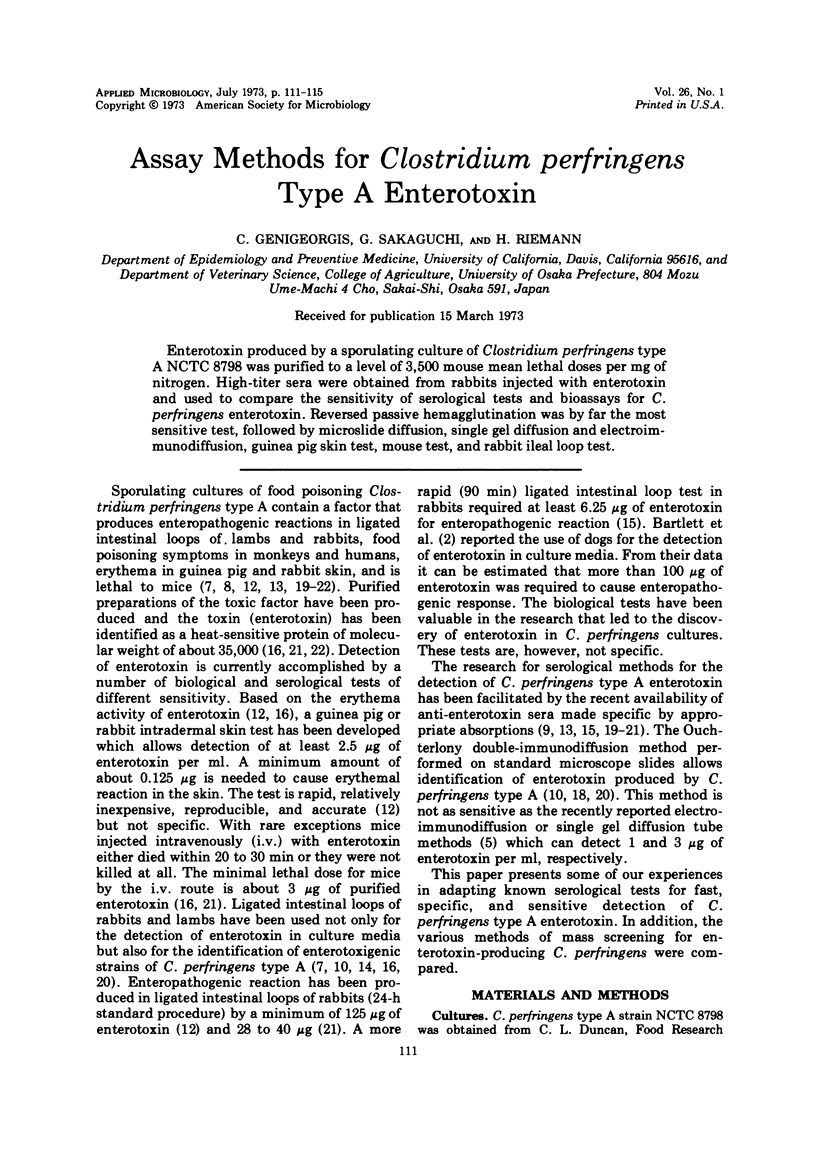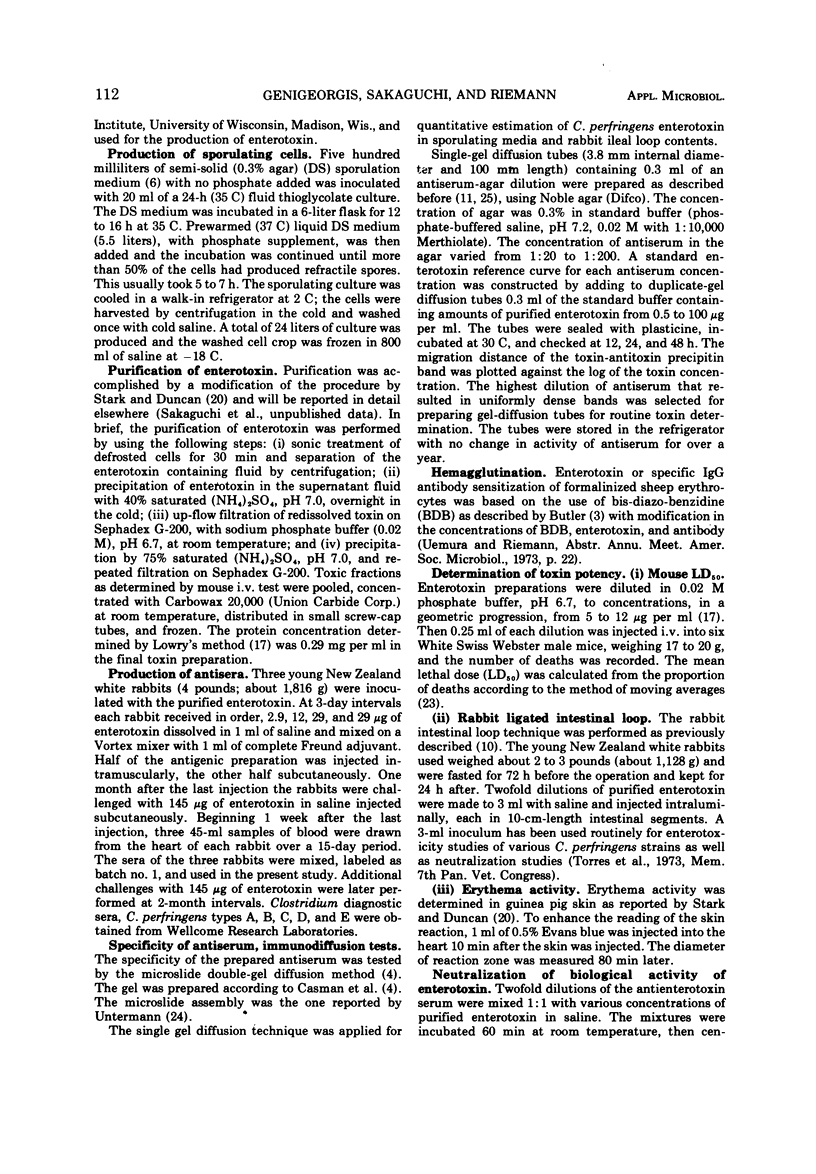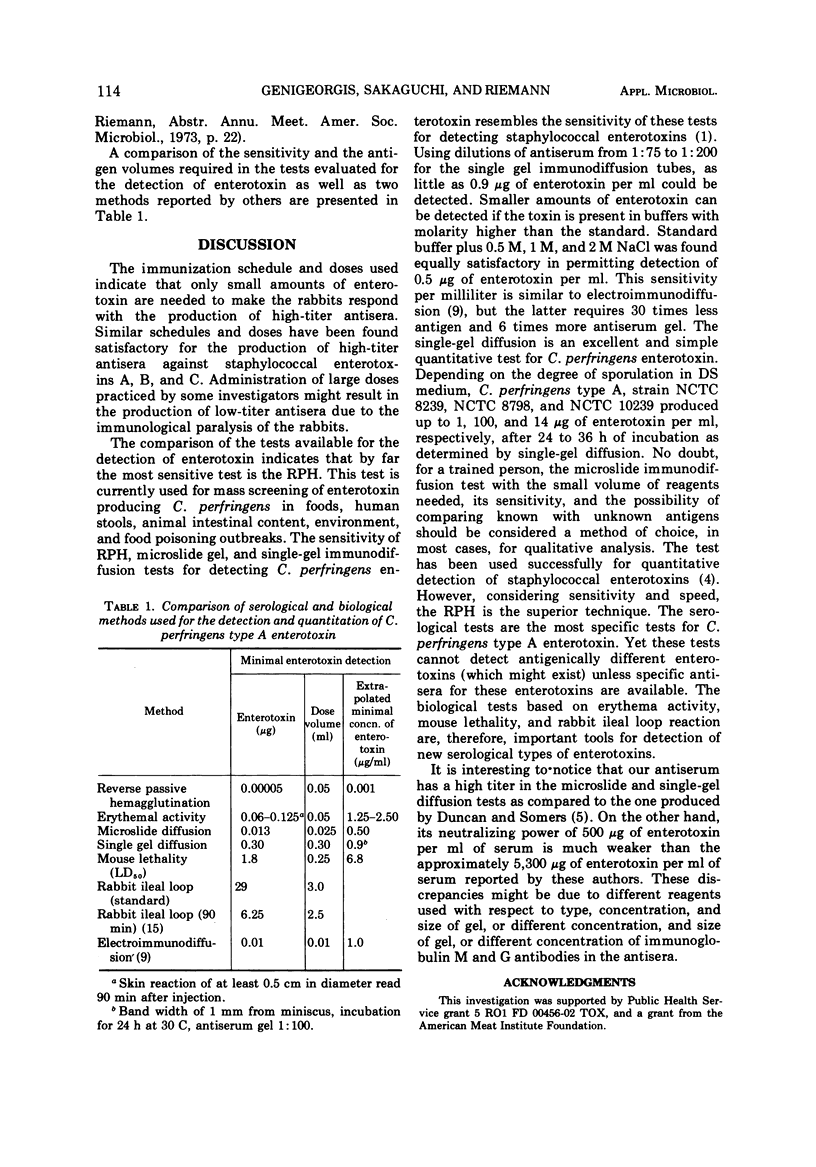Abstract
Enterotoxin produced by a sporulating culture of Clostridium perfringens type A NCTC 8798 was purified to a level of 3,500 mouse mean lethal doses per mg of nitrogen. High-titer sera were obtained from rabbits injected with enterotoxin and used to compare the sensitivity of serological tests and bioassays for C. perfringens enterotoxin. Reversed passive hemagglutination was by far the most sensitive test, followed by microslide diffusion, single gel diffusion and electroimmunodiffusion, guinea pig skin test, mouse test, and rabbit ileal loop test.
Full text
PDF




Selected References
These references are in PubMed. This may not be the complete list of references from this article.
- BUTLER W. T. HEMAGGLUTINATION STUDIES WITH FORMALINIZED ERYTHROCYTES. EFFECT OF BIS-DIAZO-BENZIDINE AND TANNIC ACID TREATMENT ON SENSITIZATION BY SOLUBLE ANTIGEN. J Immunol. 1963 May;90:663–671. [PubMed] [Google Scholar]
- Bartlett M. L., Walker H. W., Ziprin R. Use of dogs as an assay for Clostridium perfringens enterotoxin. Appl Microbiol. 1972 Jan;23(1):196–197. doi: 10.1128/am.23.1.196-197.1972. [DOI] [PMC free article] [PubMed] [Google Scholar]
- Casman E. P., Bennett R. W., Dorsey A. E., Stone J. E. The micro-slide gel double diffusion test for the detection and assay of staphylococcal enterotoxins. Health Lab Sci. 1969 Oct;6(4):185–198. [PubMed] [Google Scholar]
- Duncan C. L., Somers E. B. Quantitation of Clostridium perfringens type A enterotoxin by electroimmunodiffusion. Appl Microbiol. 1972 Nov;24(5):801–804. doi: 10.1128/am.24.5.801-804.1972. [DOI] [PMC free article] [PubMed] [Google Scholar]
- Duncan C. L., Strong D. H. Clostridium perfringens Type A Food Poisoning I. Response of the Rabbit Ileum as an Indication of Enteropathogenicity of Strains of Clostridium perfringens in Monkeys. Infect Immun. 1971 Jan;3(1):167–170. doi: 10.1128/iai.3.1.167-170.1971. [DOI] [PMC free article] [PubMed] [Google Scholar]
- Duncan C. L., Strong D. H. Ileal loop fluid accumulation and production of diarrhea in rabbits by cell-free products of Clostridium perfringens. J Bacteriol. 1969 Oct;100(1):86–94. doi: 10.1128/jb.100.1.86-94.1969. [DOI] [PMC free article] [PubMed] [Google Scholar]
- Duncan C. L., Strong D. H. Improved medium for sporulation of Clostridium perfringens. Appl Microbiol. 1968 Jan;16(1):82–89. doi: 10.1128/am.16.1.82-89.1968. [DOI] [PMC free article] [PubMed] [Google Scholar]
- Duncan C. L., Strong D. H., Sebald M. Sporulation and enterotoxin production by mutants of Clostridium perfringens. J Bacteriol. 1972 Apr;110(1):378–391. doi: 10.1128/jb.110.1.378-391.1972. [DOI] [PMC free article] [PubMed] [Google Scholar]
- Duncan C. L., Sugiyama H., Strong D. H. Rabbit ileal loop response to strains of Clostridium perfringens. J Bacteriol. 1968 May;95(5):1560–1566. doi: 10.1128/jb.95.5.1560-1566.1968. [DOI] [PMC free article] [PubMed] [Google Scholar]
- Hauschild A. H. Erythemal activity of the cellular enteropathogenic factor of Clostridium perfringens type A. Can J Microbiol. 1970 Aug;16(8):651–654. doi: 10.1139/m70-112. [DOI] [PubMed] [Google Scholar]
- Hauschild A. H., Hilsheimer R. Purification and characteristics of the enterotoxin of Clostridium perfringens type A. Can J Microbiol. 1971 Nov;17(11):1425–1433. doi: 10.1139/m71-227. [DOI] [PubMed] [Google Scholar]
- Hauschild A. H., Hilsheimer R., Rogers C. G. Rapid detection of Clostridium perfringens enterotoxin by a modified ligated intestinal loop technique in rabbits. Can J Microbiol. 1971 Nov;17(11):1475–1476. doi: 10.1139/m71-235. [DOI] [PubMed] [Google Scholar]
- Hauschild A. H., Niilo L., Dorward W. J. Clostridium perfringens type A infection of ligated intestinal loops in lambs. Appl Microbiol. 1968 Aug;16(8):1235–1239. doi: 10.1128/am.16.8.1235-1239.1968. [DOI] [PMC free article] [PubMed] [Google Scholar]
- LOWRY O. H., ROSEBROUGH N. J., FARR A. L., RANDALL R. J. Protein measurement with the Folin phenol reagent. J Biol Chem. 1951 Nov;193(1):265–275. [PubMed] [Google Scholar]
- Niilo L., Hauschild A. H., Dorward W. J. Immunization of sheep against experimental Clostridium perfringens type A enteritis. Can J Microbiol. 1971 Mar;17(3):391–395. doi: 10.1139/m71-065. [DOI] [PubMed] [Google Scholar]
- Niilo L. Mechanism of Action of the Enteropathogenic Factor of Clostridium perfringens Type A. Infect Immun. 1971 Jan;3(1):100–106. doi: 10.1128/iai.3.1.100-106.1971. [DOI] [PMC free article] [PubMed] [Google Scholar]
- Stark R. L., Duncan C. L. Biological characteristics of Clostridium perfringens type A enterotoxin. Infect Immun. 1971 Aug;4(2):89–96. doi: 10.1128/iai.4.2.89-96.1971. [DOI] [PMC free article] [PubMed] [Google Scholar]
- Stark R. L., Duncan C. L. Purification and biochemical properties of Clostridium perfringens type A enterotoxin. Infect Immun. 1972 Nov;6(5):662–673. doi: 10.1128/iai.6.5.662-673.1972. [DOI] [PMC free article] [PubMed] [Google Scholar]
- Strong D. H., Duncan C. L., Perna G. Clostridium perfringens Type A Food Poisoning II. Response of the Rabbit Ileum as an Indication of Enteropathogenicity of Strains of Clostridium perfringens in Human Beings. Infect Immun. 1971 Jan;3(1):171–178. doi: 10.1128/iai.3.1.171-178.1971. [DOI] [PMC free article] [PubMed] [Google Scholar]
- Thompson W. R. USE OF MOVING AVERAGES AND INTERPOLATION TO ESTIMATE MEDIAN-EFFECTIVE DOSE: I. Fundamental Formulas, Estimation of Error, and Relation to Other Methods. Bacteriol Rev. 1947 Jun;11(2):115–145. [PMC free article] [PubMed] [Google Scholar]
- Weirether F. J., Lewis E. E., Rosenwald A. J., Lincoln R. E. Rapid quantitative serological assay of staphylococcal enterotoxin B. Appl Microbiol. 1966 Mar;14(2):284–291. doi: 10.1128/am.14.2.284-291.1966. [DOI] [PMC free article] [PubMed] [Google Scholar]


